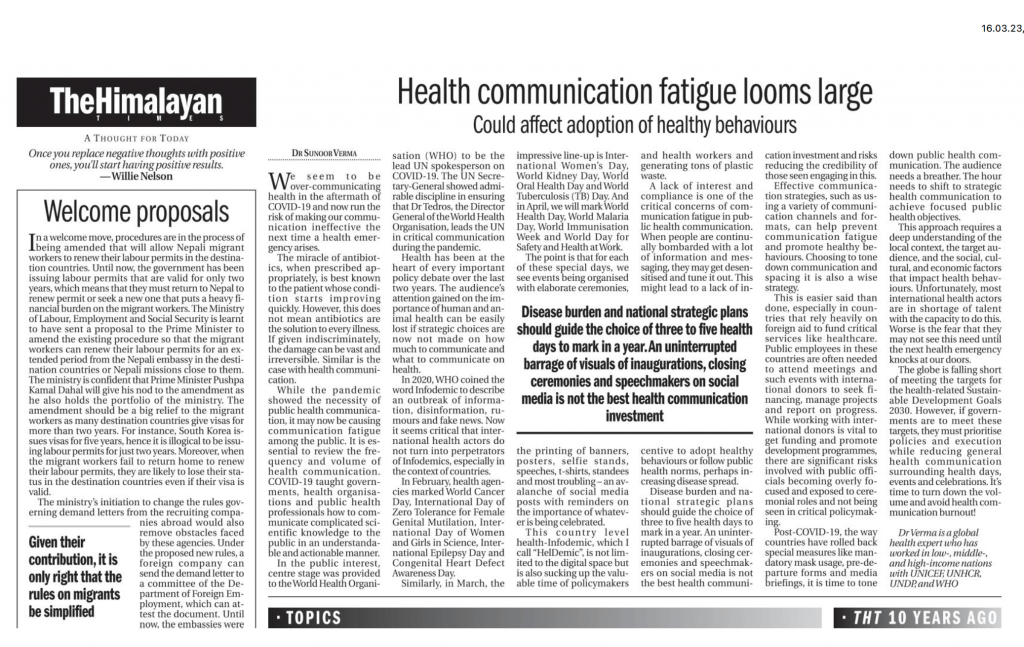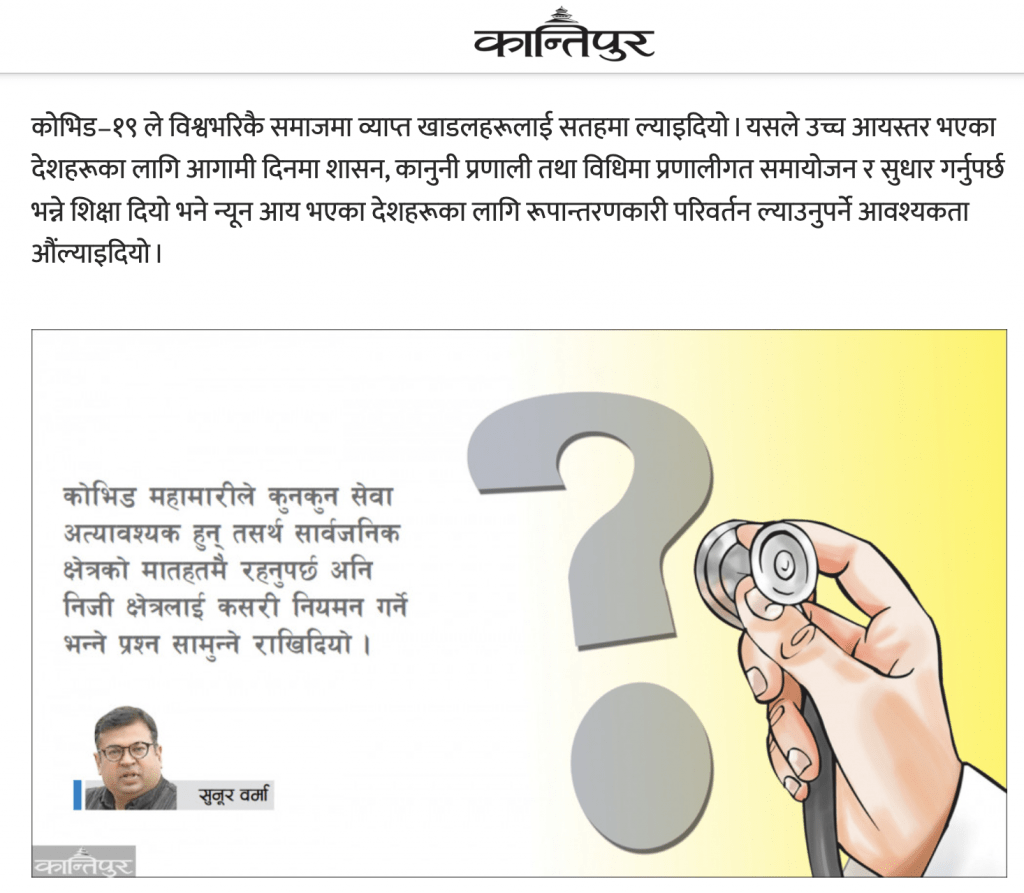Over-communicating health- can it ever be counterproductive?
We seem to be over-communicating health in the aftermath of COVID-19 and now run the risk of making our communication ineffective the next time a health emergency arises. The miracle of antibiotics, when prescribed appropriately, is best known to the patient whose condition starts improving quickly. However, this does not mean antibiotics are the solution to every illness. If given indiscriminately, the damage can be vast and irreversible. Similar is the case with health communication.
The risk of communication fatigue
While the pandemic showed the necessity of public health communication, it may now be causing communication fatigue among the public. It is essential to review the frequency and volume of health communication. COVID-19 taught governments, health organisations, and public health professionals how to communicate complicated scientific knowledge to the public in an understandable and actionable manner.
In the public interest, centre stage was provided to the World Health Organisation (WHO) to be the lead UN spokesperson on COVID-19. The UN Secretary-General showed admirable discipline in ensuring that Dr Tedros, the Director General of the WHO, leads the UN in critical communication during the pandemic. Health has been at the heart of every important policy debate over the last two years. The audience’s attention gained on the importance of human and animal health can be easily lost if strategic choices are now not made on how much to communicate and what to communicate on health.
In 2020, WHO coined the word Infodemic to describe an outbreak of information, disinformation, rumours, and fake news. Now it seems critical that international health actors do not turn into perpetrators of Infodemics, especially in the context of countries.
Endless marking of health days- risk of losing public trust and credibility
In February, health agencies marked World Cancer Day, International Day of Zero Tolerance for Female Genital Mutilation, International Day of Women and Girls in Science, International Epilepsy Day, and Congenital Heart Defect Awareness Day. Similarly, in March, the impressive line-up is International Women’s Day, World Kidney Day, World Oral Health Day, and World Tuberculosis (TB) Day. And in April, we will mark World Health Day, World Malaria Day, World Immunization Week and World Day for Safety and Health at Work.
The point is that for each of these special days, we see events being organised with elaborate ceremonies, the printing of banners, posters, selfie stands, speeches, t-shirts, standees and most troubling- an avalanche of social media posts with reminders on the importance of whatever is being celebrated. This country level health-Infodemic which I call “HelDemic”, is not limited to the digital space but is also sucking up the valuable time of policymakers and health workers and generating tons of plastic waste.
A lack of interest and compliance is one of the critical concerns of communication fatigue in public health communication. When people are continually bombarded with a lot of information and messaging, they may get desensitised and tune it out. This might lead to a lack of incentive to adopt healthy behaviours or follow public health norms, perhaps increasing disease spread.
Corrective action and celebration triage is needed urgently!
Disease burden and national strategic plans should guide the choice of three to five health days to mark in a year. An uninterrupted barrage of visuals of inaugurations, closing ceremonies and speechmakers on social media is not the best health communication investment and risks reducing the credibility of those seen engaging in this. Effective communication strategies, such as using a variety of communication channels and formats, can help prevent communication fatigue and promote healthy behaviours. Choosing to tone down communication and spacing is also a wise strategy.
Between the devil and the deep sea- tough choices for the poor
This is easier said than done, especially in countries that rely heavily on foreign aid to fund critical services like healthcare. Public employees in these countries are often needed to attend meetings and such events with international donors to seek financing, manage projects, and report on progress. While working with international donors is vital to get funding and promote development programs, there are significant risks involved with public officials becoming overly focused and exposed to ceremonial roles and not being seen in critical policymaking.
Post-COVID-19, the way countries have rolled back special measures like mandatory mask usage, pre-departure forms, and media briefings, it is time to tone down public health communication. The audience needs a breather. There is an urgent need to shift to strategic health communication to achieve focused public health objectives. This approach requires a deep understanding of the local context, the target audience, and the social, cultural, and economic factors that impact health behaviours. Unfortunately, most international health actors are in shortage of talent with the capacity to do this. Worse is the fear that they may not see this need until the next health emergency knocks at our doors.
Time to cut down the noise and deliver solid results!
The globe is falling short of meeting the targets for the health-related Sustainable Development Goals 2030. However, if governments are to meet these targets, they must prioritize policies and execution while reducing general health communication surrounding health days, events, and celebrations. It’s time to turn down the volume and avoid health communication burnout!
Published in The Himalayan Times, Thursday, 16th March 2023. Page 4.
About the Author
Dr Sunoor Verma is a global health practitioner. He has advised WHO, UNICEF, UNHCR, HUG-Geneva and Cambridge University on Strategy, Leadership Communication, Advocacy and Resource Mobilization. He is credited with setting up WHO’s communication portfolio from scratch in Nepal in the midst of COVID-19. He has set up and led the country and regional operations for the European Centre for Minority Issues in the Balkans. He has supported track two peace processes in Macedonia, Kosovo and Sri Lanka and emergency response to the Tsunami, Avian Influenza and COVID-19. He has taught Global Health at Boston University. He has curated partnership initiatives with Macedonia, Kosovo, Germany, Switzerland, Australia, and Nepal parliamentarians. He divides his time between the foothills of the Jura Mountains in France and Buddhanilkantha in Nepal.

